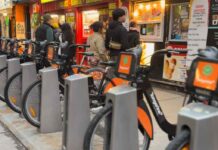THUNDER BAY – Business – When I first read Russell Gold’s March 5, 2013, Wall Street Journal piece, “Berkshire’s BNSF Railway to Test Switch to Natural Gas,” I feared the news would make such a big splash that the hydrail boat might get capsized by it. But the longer I look the more persuaded I’ve became that hydrail—hydrogen fuel cell hybrid railroad propulsion technology—is more likely to ski on the wake of Buffet’s BNSF “gastrain” dreadnought than be swamped by it.
The world’s first full-scale hydrail locomotive was introduced by BNSF on June 29, 2009 at the Port of Los Angeles. Still in service, it remains the largest fuel cell artifact ever to move on land.
Hydrail development was funded by the US Department of Defense via a project championed by (now) Kansas Governor Sam D. Brownback.
China has just rolled out its first hydrail locomotive (http://video.sina.com.cn/v/b/95989749-1802531097.html — TV news video segment, preceded by ad). It’s a project of Southwest Jiaotong University in Chengdu, Sichuan and it will be described by its creators in Toronto on 11 and 12 June, at the 8th International Hydrail Conference, http://www.hydrail.org.
Last year the University of Birmingham’s Centre for Railway Research and Education rolled out the UK’s first hydrail locomotive, Hydrogen Pioneer—a park-scale, narrow-gauge concept unit.
The Birmingham Centre celebrated Pioneer’s debut by hosting the 7th International Hydrail Conference there. The University of Birmingham will graduate its first hydrail doctorate, Germany’s Andreas Hoffrichter, this spring.
Unlike BNSF’s long-haul gastrains, hydrail technology fits the smaller rail applications, from switch engines down. The first hydrail locomotive was a mining “loco,” designed to replace battery-electric underground units that took several hours to charge-up before returning to work.
Recently AMPLATS, a major South African mining company, announced plans to test a fleet of five hydrail locos and—if successful—to begin to replace their immense underground fleet of about 800 locomotives.
BNSF’s gastrain solution to the diesel oil problem should create an attractive “build toward the middle from both ends” situation. I do not doubt that a carbon-free hydrail universe is still the mid-century end state for railroads. The Buffet-BNSF gas/diesel innovation should help to get us there much sooner.
BNSF’s move to natural gas rail traction power will be a world-shaking transformation that ranks “with the industry’s historic transition away from steam engines in the last century,” as Russell Gold quotes Chief Executive, Matt Rose, as saying.
But in Europe, and perhaps in Asia, hydrail still has “the main line” to itself. Natural gas’s carbon footprint problematic (fracking) sourcing still point toward hydrail becoming the next general railroad traction technology for most of the world.
In the USA, natural-gas-powered streetcars for new line construction (not replacements) would make a lot more sense than spending $10 million-per-mile to construct tacky overhead electrification superstructure. But silent, more efficient, zero-carbon hydrolleys (H2 streetcars) would make even more sense.
“Hydrail” is still hardly a household word, though the technology has existed for nearly a decade. Natural gas diesel, unlike hydrail, is still on the drawing boards.
While it’s there, here’s hoping that the Caterpillar and General Electric locomotive developers mentioned in the WSJ story have the wisdom to anticipate and design for a post-carbon future—when the gas powering modified diesel locomotives is renewably-sourced hydrogen rather than exhaustible, climate-problematic, natural gas.
Stan Thompson
For information on hydrail’s international progress so far, visit Appalachian State University’s web site, http://www.hydrail.org.







